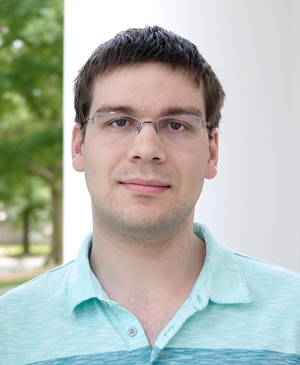Three Graduate Students Receive 2017 NASA Earth and Space Science Fellowships
James Juno, Thomas Rimlinger and Joseph Schools receive awards of up to $45,000 per year
Three graduate students in the University of Maryland College of Computer, Mathematical, and Natural Sciences have been awarded 2017 NASA Earth and Space Science Fellowships. The purpose of the fellowships is to ensure continued training of a highly qualified workforce in disciplines needed to achieve NASA’s scientific goals.
James Juno, Thomas Rimlinger and Joseph Schools will each receive the award, which provides up to $45,000 a year toward a stipend and other expenses.
James Juno, Ph.D. student in physics
Advisor: Jason TenBarge, assistant research scientist in the Institute for Research in Electronics and Applied Physics
“Continuum kinetic studies of turbulence in the heliosphere”
Juno will study turbulence in the heliosphere—the bubble that encompasses the solar system. The sun flings a plasma of charged particles, known as the solar wind, into the heliosphere at speeds of over a million miles per hour. Because the solar wind can damage spacecraft and satellites, studying the wind is important for everything from space exploration to telecommunications infrastructure. One unexplained aspect of the plasma is its unexpectedly high temperature. Juno plans to develop kinetic models of plasma particles to discover whether energy transfer between the sun’s electromagnetic field and the plasma particles raises the temperature of the solar wind. Juno earned his bachelor’s degree in physics from Rice University.
 Thomas Rimlinger (B.S. ’14, astronomy; B.S. ’14, mathematics), Ph.D. student in astronomy
Thomas Rimlinger (B.S. ’14, astronomy; B.S. ’14, mathematics), Ph.D. student in astronomy
Advisor: Douglas Hamilton, professor of astronomy
“Formation and evolution of Titan and Hyperion”
Rimlinger will research the origins of Titan and Hyperion, two of Saturn’s moons. Titan, Saturn’s largest moon, boasts a uniquely large mass, dense atmosphere, relatively large eccentricity and orbital tilt. In addition, Titan always completes four orbits for every three orbits by Hyperion. Because no standard model explains these properties of the two moons, Rimlinger will simulate satellite systems to investigate the theory that Titan and Hyperion both arose from an ancient set of small moons that eventually merged into larger moons. These findings may provide clues to how other moons—including Earth’s—may have formed. Rimlinger earned bachelor’s degrees in astronomy and mathematics at UMD.
 Joseph Schools, Ph.D. student in geology
Joseph Schools, Ph.D. student in geology
Advisor: Laurent Montési, associate professor of geology
“Development and instability of melt decompaction layers in the Ionian lithosphere and their effect on the evolution, movement, and spacing of volcanic centers”
Schools will examine the outer shell, or lithosphere, of Jupiter’s moon Io—the most volcanically active body in the solar system. A number of areas with high volcanic activity sit across the moon’s surface, and previous work shows that these hot spots—especially those near the equator—are spaced away from each other. Schools will study whether molten rock, or magma, rising through the lithosphere could be causing this spacing. He will also investigate whether crystallized magma can constrain further magma movement on Io, forming permeability barriers as it likely does on Earth’s ocean floor. To do this, Schools will develop models of Io’s permeability barrier and the resulting volcanic activity, and then compare his results with the observed volcanic features on Io. Schools earned his bachelor’s degree in earth and planetary sciences at the University of California, Santa Cruz.
###
Media Relations Contact: Irene Ying, 301-405-5204, zying@umd.edu
University of Maryland
College of Computer, Mathematical, and Natural Sciences
2300 Symons Hall
College Park, MD 20742
www.cmns.umd.edu
@UMDscience
About the College of Computer, Mathematical, and Natural Sciences
The College of Computer, Mathematical, and Natural Sciences at the University of Maryland educates more than 7,000 future scientific leaders in its undergraduate and graduate programs each year. The college’s 10 departments and more than a dozen interdisciplinary research centers foster scientific discovery with annual sponsored research funding exceeding $150 million.








